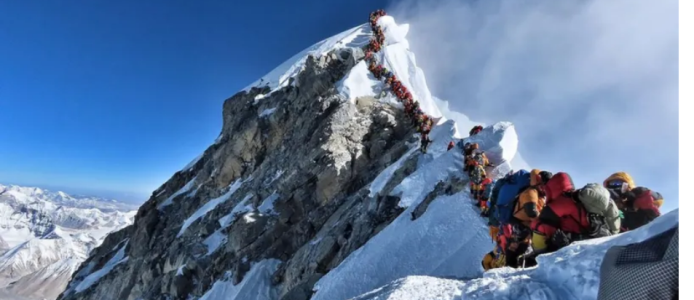At 29,032 feet above sea level, where the oxygen is a third of what it is at sea level and temperatures can drop to -80°F, Mount Everest pierces the sky with a quiet majesty. Often compared to the cruising altitude of private jets, Everest isn’t just Earth’s tallest mountain, it’s a symbol of the extreme edge of human endurance.

Each year, hundreds of climbers from around the world converge on its icy slopes with a single dream: to stand at the top of the world. But behind the glamour shots and flags at the summit lies a brutally honest truth, Everest doesn’t hand out victories easily. For every climber who reaches the peak, there’s a story not of conquest, but of survival, heartbreak, and resilience.
Take, for instance, the journey of Shahbaz Khan, a Pakistani schoolteacher who saved for over a decade to fund his Everest attempt. With no sponsors and limited climbing experience, he joined a guided expedition in 2019. Battling frostbite, dwindling oxygen, and altitude-induced hallucinations, Shahbaz didn’t summit, but he made it to Camp IV, just 3,000 feet from the top. That might seem like a failure to some. But for Shahbaz, it was the summit of self-discovery. “I didn’t conquer Everest,” he said in a post-climb interview. “But I conquered everything I thought I couldn’t do.”
There’s also the silent story of the Sherpas, the unsung heroes of every Everest expedition. While international climbers may spend two months acclimatizing, Sherpas make multiple high-altitude trips, setting ropes and carrying supplies, all with unmatched endurance and humility. Many have summited the mountain more than a dozen times, yet few outside the climbing community know their names.
One such man, Kami Rita Sherpa, has climbed Everest 30 times, a world record. Yet in interviews, he shrugs off fame. “I’m just doing my job,” he says. A job that includes risking his life in the death zone, day after day. Climbing Everest is not about beating nature, it’s about confronting the raw limits of the human body and spirit. Altitude sickness, avalanches, and frostbite are just some of the adversaries climbers face. And yet, they go on, doctors, teachers, artists, and adventurers, each with a deeply personal reason to test themselves against the highest place on Earth.
At 39,000 feet, a commercial jet slices the air with the power of engines and pressurized cabins. But at 29,032 feet, human beings rely on nothing but their will, their training, and a breath they can barely catch. So the next time you fly over the Himalayas and glimpse that rugged peak out your window, remember: Everest isn’t just a mountain. It’s a mirror, reflecting what’s possible when ordinary people choose to do something extraordinary.



